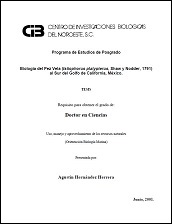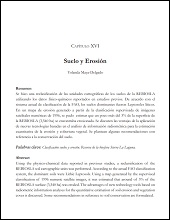Efecto de diferentes niveles de proteína en la dieta, sobre el crecimiento, eficiencia alimenticia y composición proximal del pargo amarillo Lutjanus argentiventris
Effect of varying dietary protein levels on growth, feeding efficiency, and proximate composition of yellow snapper Lutjanus argentiventris (Peters, 1869)
Author
MINERVA CONCEPCION MALDONADO GARCIA
JESUS RODRIGUEZ ROMERO
MARTHA CANDELARIA REYES BECERRIL
CARLOS ALFONSO ALVAREZ GONZALEZ
ROBERTO CIVERA CERECEDO
MILTON SPANOPOULOS HERNANDEZ
Metadata
Show full item recordAbstract
"El efecto de diferentes niveles de proteína en la dieta (31, 41, 45 y 55%) fue evaluado por cuadruplicado en el pargo amarillo Lutjanus argentiventris. Los organismos fueron mantenidos en 16 tanques de plástico de 200 L por 95 días y los valores de crecimiento, eficiencia alimenticia y composición proximal del pargo amarillo (18 g) fueron examinados. Cada 15 días se llevaron a cabo mediciones de peso individual y longitud estándar del total de la población. Al inicio y al final del experimento, muestras de hígado y músculo fueron tomadas para análisis proximal de proteína cruda y extracto etéreo. En general, la ganancia de peso más alta fue obtenida con los peces alimentados con 55% de proteína. La mejor tasa de conversión alimenticia (FCR), tasa de crecimiento específico (SGR), porcentaje de ganancia de peso (WG%), ganancia diaria promedio (ADG) y tasa de eficiencia alimenticia (FER) se obtuvo con los niveles más altos de proteína cruda. El contenido de proteína en hígado disminuyó en los peces alimentados con los niveles de proteína y energía más altos comparados con el pez inicial. Finalmente, el uso de dietas prácticas conteniendo 55% de proteína cruda es apropiado para un óptimo crecimiento y eficiencia en la utilización del alimento del pargo amarillo. El resultado obtenido en este estudio puede ser debido a la fase temprana de desarrollo del pargo amarillo, donde los requerimientos de proteína y energía son más elevados." "The effect of dietary protein (31, 41, 45, and 55%) was evaluated in quadruplicate in the yellow snapper (Lutjanus argentiventris). Specimens were kept in sixteen 200 L plastic tanks for 95 days and the values of growth rate, feeding efficiency and proximate composition of yellow snapper (18 g) were examined. Every 15 days were carried out individual weight measurements and standard length of the total population. At the beginning and end of the experiment, liver and muscle samples were taken for proximate analysis of crude protein and ether extract. In general, the highest gain was obtained with fish fed with 55% crude protein in the diet. The best feed conversion ratio (FCR), specific growth rate (SGR), percent weight gain (WG%), average daily gain (ADG), and feed efficiency rate (FER) were obtained with the fish fed 55% of protein (CP). The protein content in liver decreased in fish fed with protein levels and higher energy compared with the initial fish. Finally, the use of practical diets containing 55% CP is appropriate for optimal growth and efficiency of feed utilization of yellow snapper. The results obtained in this study may be due to the early stage of development of yellow snapper where protein and energy requirements are higher."
Collections
Related items
Showing items related by title, author, creator and subject.
-
PROMOCIÓN DEL PERIFITON PARA EL CULTIVO DE CAMARÓN BLANCO: HACIA UNA ACUICULTURA ECOLÓGICA
DOMENICO VOLTOLINA LOBINA; JUAN MANUEL AUDELO NARANJO; MARIA DEL ROSARIO PACHECO MARGES -
Suelo y Erosión
YOLANDA LOURDES MAYA DELGADO


